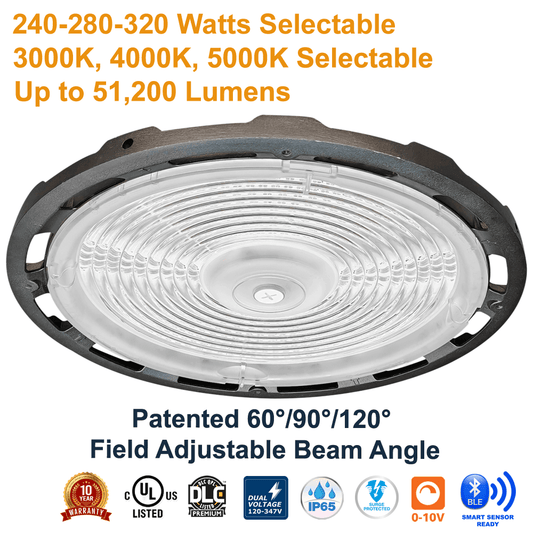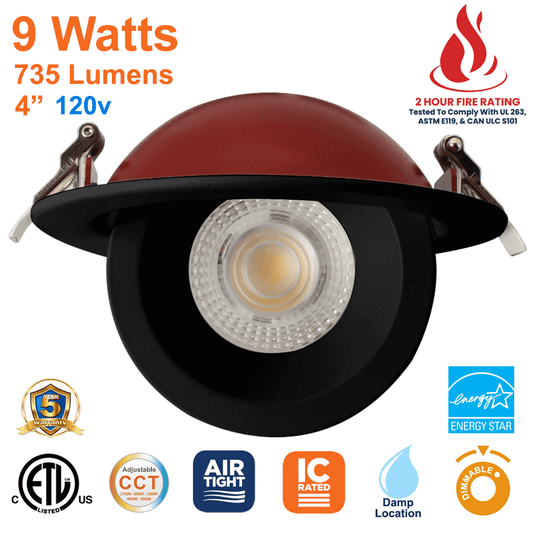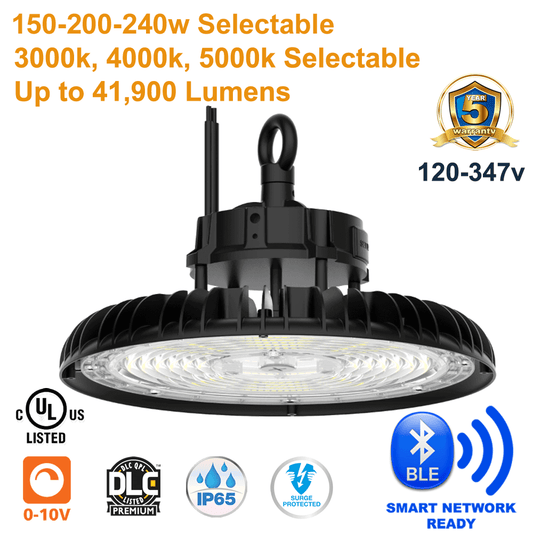Lighting technology has come a long way since the days of dim, yellow bulbs that could hardly illuminate a room. Now, with advancements in LED Lighting, consumers have access to brighter, more efficient solutions. Particularly in Commercial LED Lighting and Industrial LED Lighting, the Lumen per Watt ratio has become an essential metric in gauging the effectiveness of LED Lighting products. But what exactly does Lumens per Watt mean, and why is it so important?
What Does Lumens Per Watt Mean?
Simply put, Lumens per Watt (Lm/W) is a measure of light output (lumens) for every unit of power (watts) that a light source consumes. Think of it as the lighting world's version of kilometers per 100 litres in cars. It essentially gauges the efficiency of a light bulb or light fixture. And in realms of Commercial Lighting and Industrial Lighting, efficiency is paramount.
Do Lumens Per Watt Matter?
Absolutely. This metric is crucial in determining the energy efficiency of a light fixture. Especially for businesses looking for LED High Bay solutions or the right LED Parking Lot Light, understanding Lm/W plays a crucial role in making an informed decision. An efficient lighting solution not only reduces energy consumption but also brings down operational costs over time.
“Economic and Efficient LED Lighting isn't just about saving pennies; it's about creating a brighter, more sustainable future.”
How Do Lumens Per Watt Differ Between Different Types Of Lighting Technologies?
-
LED: LEDs stand tall when it comes to energy efficiency. Their intricate design allows them to emit light without wasting much energy in the form of heat. This makes them perfect candidates for both Industrial and Commercial Lighting solutions.
-
Halogen: These bulbs produce light by passing electricity through a tungsten filament, which is surrounded by halogen gas. Although they're brighter than traditional incandescent bulbs, their Lm/W is typically lower than that of LEDs.
-
Compact Fluorescent: Often recognized by their twisty design, these bulbs are more efficient than both incandescent and halogen bulbs but fall short when compared to LEDs.
-
Fluorescent: Commonly used in office settings, these tubes have a decent Lm/W ratio but still fall well behind more efficient LED alternatives.
-
Metal Halide & High Pressure Sodium: Both are types of High-Intensity Discharge (HID) lamps. While they produce a lot of light, they are not as efficient as LED solutions, particularly when you factor in their longer warm-up times.
Is More Lumens Per Watt Better?
Yes. A higher Lm/W ratio indicates that the bulb or fixture produces more light for every unit of energy it consumes. This translates to better energy efficiency and reduced energy costs. It's no wonder that so many businesses are now switching to LED Light Fixtures and bulbs.
What's the difference between Lumens Per Watt and Luminous Efficacy?
Luminous Efficacy is the ability of a light source to convert electrical power to light. While they might seem similar, think of Lumens Per Watt as the outcome and Luminous Efficacy as the potential. Both metrics go hand in hand to determine the efficiency of a light source.
With the global push towards greener and more sustainable solutions, understanding Lumens per Watt is essential. It's not just about illumination; it's about illuminating wisely. Whether you're exploring options for Networked Lighting Controls or hunting for the perfect LED Panel Light, it pays to be informed.
Stay tuned for the next section where we dive deeper into the relationship between Lumens and Watts, the importance of Lm/W in lighting decisions, and the technological advancements that continue to shape the lighting industry.
Lighting's Evolution: Lumens, Watts, and the Technological Shift
As lighting technologies continue to evolve, understanding the nuances of lumens and watts has never been more critical. Especially for businesses aiming to capitalize on the best in Commercial Lighting, every bit of knowledge can lead to significant cost savings and optimized operational efficiency.
Why Are Lumens Per Watt Important in Lighting?
Lumens per Watt represent the cornerstone of energy efficiency in the lighting realm. Businesses worldwide, whether they require LED Strip Lights for ambiance or heavy-duty LED Shop Lights for industrial tasks, prioritize Lm/W to achieve maximum brightness with minimal energy consumption. Higher Lm/W ratios mean that the lighting solution is utilizing energy more efficiently, contributing to:
- Reduced energy costs
- Lower carbon footprints
- Longer bulb or fixture lifespan
How do LED Fixtures’ L70 Relate to Original Lumens Per Watt?
The term L70 refers to the point in time when an LED emits 70% of its original lumen output. It's a benchmark used to measure the longevity and performance depreciation of an LED. As LEDs age, their Lm/W decreases. Ensuring your LED lighting solutions have a high L70 can ensure consistent performance for years.
How Do I Calculate Lumens Per Watt?
It's quite straightforward:
Lumens Per Watt = Total Lumens (of the bulb or fixture) ÷ Total Watts (power consumption)
For a different spin on this calculation, check out How to Convert Lumens to Watts: A Guide for 2023, where we show you how to calculate an LED fixture’s power consumption based on its lumen output.
Do Different Types of LED Fixtures Have Different Lumens Per Watt?
Absolutely. For instance, a UFO LED High Bay designed for expansive spaces like warehouses will have a different Lm/W compared to smaller fixtures like an LED Pot Light. Several factors influence these differences, from design and intended use, to the technology embedded within, to a fixture’s ability to dissipate heat.
What's More Important, Lumens or Watts?
Lumens and watts serve different purposes:
-
Lumens: Measures the actual brightness produced. It’s the real-world output that you experience in the form of light.
-
Watts: Indicates power consumption. It's an essential factor when considering energy bills and environmental impact.
In an age where efficiency is a top priority, lumens (light output) often take precedence. However, when making a purchasing decision, considering both metrics ensures an "Economic and Efficient" lighting solution.
What's the Relationship between Lumens and Watts?
Lumens and watts are interconnected. Lumens per Watt, as discussed earlier, gives an efficiency ratio, revealing how many lumens are produced for every watt consumed. As technologies like LED Lighting continue to improve, we get more lumens from fewer watts – signifying advancements in energy efficiency.
Understanding lumens and watts is fundamental in today's rapidly changing lighting landscape. By staying informed, businesses can make smarter choices, whether they're considering adding Networked Lighting Controls or exploring the vast range of LED lighting options available.
In our next segment, we'll explore the influence of color temperature on Lm/W, the reason behind varied Lm/W ratios in different LED sizes, and much more. Stay illuminated!
Delving Deeper: The Nuances of Lumens Per Watt in Modern Lighting Solutions
The world of Commercial LED Lighting is not just about brightening spaces. It's about creating the perfect ambiance, ensuring safety, reducing energy bills, and enhancing productivity. In the final leg of our exploration, we'll uncover more layers about Lumens per Watt (Lm/W) to help you make the most informed decisions for your lighting needs.
Does Colour Temperature Influence Lumens Per Watt?
In many cases it does. The colour temperature, measured in Kelvins (K), determines the warmth or coolness of light. While the colour temperature itself doesn’t directly change the Lm/W, the efficiency of the LEDs can vary depending on the temperature spectrum. Typically, cooler lights (higher Kelvins) tend to have slightly higher Lm/W compared to warmer lights.
Why Do Larger LED Lights, like High Bays, Seem to Have Higher Lumens Per Watt than Small LED Lights, like Pot Lights?
Larger fixtures, such as LED High Bay Lights, are designed for vast spaces and require higher efficacy to be energy efficient. Their design often incorporates advanced cooling mechanisms, allowing the LEDs to operate more efficiently. Conversely, smaller fixtures like down lights, found in our down light collection, are confined in both size and space, impacting heat dissipation and Lm/W ratio.
Do Lumens Per Watt Change if You Dim an LED Light?
Dimming LED lights can influence their efficacy. As the power to the LED decreases during dimming, its efficiency might increase, producing more lumens per watt. However, this relationship isn't always linear. For a detailed look at dimming LEDs, refer to our article on LED dimming options for 2023.
If I Add Networked Lighting Controls to an LED Fixture, Will the Lumens Per Watt Change?
Adding Networked Lighting Controls primarily impacts the operational hours and usage patterns of the LEDs. While the inherent Lm/W of the LED might remain unchanged, the overall energy savings and efficiency of the lighting system can significantly improve. With features like dimming, occupancy sensing, and daylight harvesting, these controls ensure LEDs operate at their optimal levels.
Are Lumens Per Watt Different Than Usable Lumens?
Yes. Lumens Per Watt refers to the overall light output against energy consumption. On the other hand, usable lumens refer to the amount of light that actually contributes to illuminating a space, discounting any wastage due to fixture design or positioning.
Conclusion: Illuminating the Future with Knowledge
As we navigate the intricate labyrinth of Commercial and Industrial LED Lighting, it's evident that understanding lumens, watts, and their interplay is pivotal. From choosing the ideal LED Parking Lot Light to optimizing an office space with the perfect ceiling lights, every decision contributes to a brighter, more "Economic and Efficient" future.
Stay enlightened with us, and continue exploring our LED Network Blog for more insights into the world of advanced lighting solutions.




























